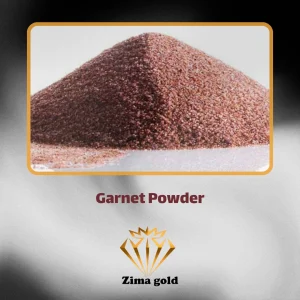Garnet Powder: A Natural, Powerful, and Safe Abrasive for Modern Industries
Garnet powder is one of the most widely used natural abrasives in industrial applications. Thanks to its high hardness, chemical stability, and eco-friendly nature, garnet has gained popularity across industries for surface treatment, cutting, and filtration. Derived from crushed garnet stone, it is available in various mesh sizes to suit different needs.
In this article, we’ll explore the benefits, applications, technical considerations, and common questions about garnet powder.
Advantages of Garnet Powder Over Other Abrasives
1. High Hardness and Uniform Granules
With a Mohs hardness of 6.5–7.5, garnet offers powerful cutting and abrasion properties. It can effectively clean or shape hard materials such as metal, glass, and stone.
2. Free from Crystalline Silica
Unlike silica sand, garnet is silica-free, reducing the risk of respiratory conditions like silicosis. This makes it safer for operators and more compliant with health regulations.
3. Low Dust Emission
Garnet produces very little dust during use, whether in dry blasting or waterjet cutting, contributing to a safer and cleaner work environment.
4. Reusability
High-quality garnet can be recycled up to 5 times in dry blasting applications, significantly reducing long-term operational costs.
Common Applications of Garnet Powder
🔧 1. Sandblasting
Used as a standard abrasive in surface preparation—removing rust, old paint, and mill scale before coating or painting.
💦 2. Waterjet Cutting
Finely graded garnet is injected into high-pressure water streams to cut materials like stone, ceramic, and metal with high precision.
🔍 3. Precision Polishing and Lapping
Fine garnet powder is used for polishing delicate components in optical, electronic, and metalworking industries.
🧪 4. Industrial Water Filtration
Some types of garnet powder are used in multi-layer filtration systems for water treatment due to their chemical stability and particle size.
Key Tips When Using Garnet Powder
-
📦 Select the correct mesh size: For sandblasting, mesh 30/60 or 80 is ideal. For waterjet, mesh 80 or 120 is preferred.
-
🏷️ Check the origin: Garnet from India, Australia, or Iran may differ in purity and performance.
-
♻️ Opt for reusable grades: High-purity garnet can be reused, cutting down on long-term costs.
-
☢️ Avoid contaminated sources: Always ensure garnet is free of heavy metals and toxic impurities, especially in filtration applications.
-

Garnet Powder
Asked Questions
❓ Is garnet powder dangerous to health?
✅ Answer: No. Unlike silica-based abrasives, garnet is free of free crystalline silica, making it safer for respiratory health.
❓ How many times can garnet powder be reused?
✅ Answer: Depending on quality and usage, garnet can be recycled 3–5 times, especially in controlled dry blasting environments.
❓ Is garnet suitable for precision cutting?
✅ Answer: Yes. Mesh sizes 80 or 120 garnet are standard in waterjet cutting for sharp, clean edges on metal, glass, and stone.
❓ How can I ensure I’m buying high-quality garnet ?
✅ Answer: Look for purity over 95% (typically almandine garnet), uniform red or dark brown color, low dust generation, and proper certification from trusted suppliers.
Conclusion
Garnet powder is a versatile, natural abrasive that stands out for its safety, reusability, and performance. From surface preparation and cutting to polishing and filtration, it serves a wide range of industries. Choosing the right type and mesh size of garnet can significantly improve efficiency, reduce costs, and maintain a safe working environment.

